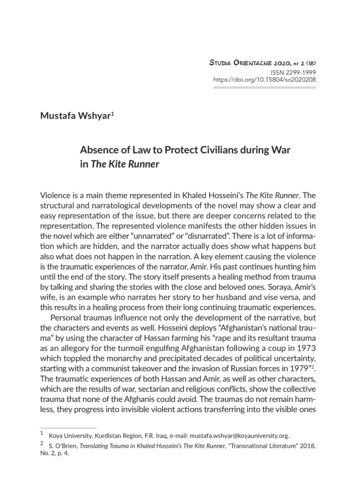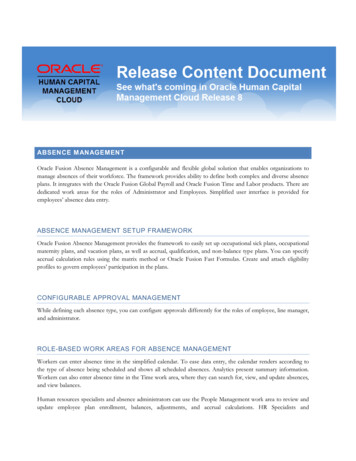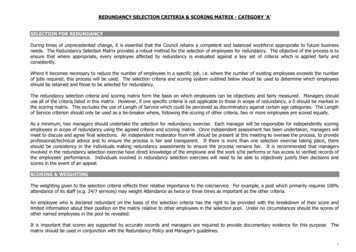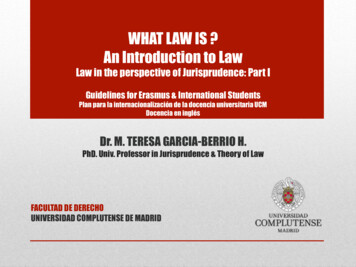
Transcription
Studia Orientalne 2020, nr 2 (18)ISSN 2299-1999https://doi.org/10.15804/so2020208Mustafa Wshyar1Absence of Law to Protect Civilians during Warin The Kite RunnerViolence is a main theme represented in Khaled Hosseini’s The Kite Runner. Thestructural and narratological developments of the novel may show a clear andeasy representation of the issue, but there are deeper concerns related to therepresentation. The represented violence manifests the other hidden issues inthe novel which are either “unnarrated” or “disnarrated”. There is a lot of information which are hidden, and the narrator actually does show what happens butalso what does not happen in the narration. A key element causing the violenceis the traumatic experiences of the narrator, Amir. His past continues hunting himuntil the end of the story. The story itself presents a healing method from traumaby talking and sharing the stories with the close and beloved ones. Soraya, Amir’swife, is an example who narrates her story to her husband and vise versa, andthis results in a healing process from their long continuing traumatic experiences.Personal traumas influence not only the development of the narrative, butthe characters and events as well. Hosseini deploys “Afghanistan’s national trauma” by using the character of Hassan farming his “rape and its resultant traumaas an allegory for the turmoil engulfing Afghanistan following a coup in 1973which toppled the monarchy and precipitated decades of political uncertainty,starting with a communist takeover and the invasion of Russian forces in 1979”2.The traumatic experiences of both Hassan and Amir, as well as other characters,which are the results of war, sectarian and religious conflicts, show the collectivetrauma that none of the Afghanis could avoid. The traumas do not remain harmless, they progress into invisible violent actions transferring into the visible ones12Koya University, Kurdistan Region, F.R. Iraq, e-mail: mustafa.wshyar@koyauniversity.org.S. O’Brien, Translating Trauma in Khaled Hosseini’s The Kite Runner, “Transnational Literature” 2018,No. 2, p. 4.
116Artykuły Articles Стaтьиof which abolishing becomes unimaginable. According to Jefferess: “there hasbeen diverse approaches to interpreting the novel – as ethnography, coming-ofage narrative, and/or morality tale” and “the text’s apparent humanizing functionreflects current theories of a cosmopolitan ethics”3. The novel can be read asa semi-reliable text for the readers to understand not only the history of Afghanistan, but also the structural establishment of social, cultural, and religiousaspects of the country. Nevertheless, the novel is certainly a fictionalized storyand it should be treated as such but it can be rather a notable and significantresource to the reader understanding the situation and structure in Afghanistan.Amir and Hassan become the main characters of the narrative whom lifeand actions put influence on the developments of their lives. It is true thatAmir continues struggling (even when he is mature) with the guilt of not preventing the rape of Hassan by Assef, but he “uses storytelling as a healing tool”to recover from the pain of the guilt from his childhood4. Hassan, however,becomes a mediator symbolizing the root issues of the narrator with his ownfather as he builds jealousy toward the sympathy of his father to Hassan5.Thus, the story telling by Amir helps him and all the other characters to “makesense of themselves, one another, and the world”6. That process is a key element of healing from traumatic experience as the characters start to knowthe reasons behind things happening and this may reduce the possible violentactions. According to an argument, the act of storytelling by Amir is seen “asan important means of characterization, and helps characters to overcometraumatic experiences”7. Then, if a traumatic experience may cause a violentaction and suffering, storytelling can be an effective tool to prevent possibleharm not only to the self but toward other individuals as well.The narrative style of this novel is helping the characters in shaping theirpast, in other words, to “create the past”8. The narrator looks back in the pastand suffers from all the issues which were the main traumatic events in his3D. Jefferess, To Be Good (Again): The Kite Runner as Allegory of Global Ethics, “Journal of PostcolonialWriting” 2009, No. 4, p. 390.4K. Nayebpour, The Use of Storeytelling in Khaled Hosseini’s The Kite Runner, “Hacettepe UniversityJournal of Faculty of Letters” 2018, No. 1, p. 53.5E. Lee, Domesticating The Subaltern in The Global Novel in English, “The Journal of CommonwealthLiterature” 2012, No. 3, p. 327.67D. Herman, Basic Elements of Narrative, Oxford 2009, p. 54.A. Nünning, R. Sommer, The Performative Power of Narrative in Drama: On the Forms and Functionsof Dramatic Storytelling in Shakespeare’s Plays, [in:] Current Trends in Narratology, ed. G. Olson, Berlin2011, p. 220.8N.R. Norrick, Conversational Storytelling, [in:] The Camridge Companion to Narrative, ed. D. Herman,New York 2007, p. 139.
M. Wshyar Absence of Law to Protect Civilians117life; narrating the life of the narrator is “at once a product and agent of history;the site of experience, memory, storytelling and aesthetic judgment; an agentof knowing as much as of action”9. As the narration becomes an inclusiveproduct, the narrator and the characters can use it as a healing tool to healtheir traumatic experiences which caused violence and made everyone suffer.Those are the happened and represented scenes while there are others whichdid-not-happened-but-could-happen-scenes that would change the directionof the story. It is important to see what happened and what did not happento explore the results that took place and the ones which would take place incase of happening something that did not happen.Literature is not a text to be read in a free time as a material to pleasureour desires. It is rather to understand the messages behind the text. Not onlythat – it is also to explore the hidden codes within the used language in orderto analyze the bigger picture of which can be related to the life of the readeror at least the world s/he lives in. Edward Said argues10:Whatever I’ve done politically has been entirely dependant on the ability to read critically, to be able to understand the uses to which language can be put. And here I mean to refer to the truly vast range ofpossibilities that language has. I think the only place you can get a senseof this range, and a feeling for these possibilities, is through the studyof literature. Because that’s what literature in a sense is about. Writingis not only about describing the world, and writing about it realistically,and reporting it [ ].Likewise, literature should be read to understand and comprehend thingsnot only in a simple and surface way, but rather critically. Beside consideringthe use of language and the variety of vocabularies, narratological methods importantly assist in the critical reading. Therefore, it is not enough to see whatthe narrator represents and what is happening in a narration, but the readerhas to look for what is not happening and not told, as well as for the reasonsbehind hiding those details. If we mean to look at a text critically and look fora theme like violence to see how it is represented, this is a proper way of doing, that as seeing only the represented violence in a text may not be of ourintention as much, as the reasons behind causing those violent acts. These allcan help to see the text as a healing tool for the narrator and characters, butthe reader may find it as a medium in solution seeking for himself. In this pa9J. Biehl, B. Good, A. Kleinman, Introduction: Rethinking Subjectivity, [in:] Subjectivity: EthnographicInvestigations, eds. J. Biehl, B. Good, A. Kleinman, Berkeley 2007, p. 14.10Ibidem, p. 124.
118Artykuły Articles Стaтьиper, Johan Galtung’s direct violence, in his theory named as violence triangle,will be used as a part of theoretical framework to identify direct violence.Galtung introduces violence triangle in his two articles “Violence, Peace andPeace Research”11 and “Cultural Violence”12. He simply divides violence intothree types: structural, cultural, and direct. Galtung defines direct violence asa visible part in which individuals are involved in directly while structural violence exists between groups and entities, and cultural violence is the involvement of the others to give a validation and acceptance toward the committedstructural violence, leading to the existence of the last type, direct violence.“Disnarration” is a narratological method used in this paper to show how itaffects the representation of violence. This term is defined in the article “TheDisnarrated”13 and according to the definition “disnarration”, is what is not represented in fictional works and what is not happening in a narrative. In a following work14, the term is widened and the explanation toward the definitionof the term is: “the elements in a narrative that explicitly consider and refer towhat does not take place (“X did not happen”; “Y could have happened but didnot”)”. “Disnarration” focuses on what did not happen while it could happenand if it happened, the story might have progressed in a different direction.This is a type of criticism to criticize the past in a context to consider the possible outcomes, mostly positive ones. Here, the didacticism is more obviousto advice the reader what leads certain conclusion and the same paths shouldnot be followed again as it led to negative endings. Then, “disnarration” is important in stories because “Counterfactual scenarios are evocative not onlybecause they illustrate attitudes, but because they often depict near, misses,lost opportunities, and foreclosed possibilities”15. Counter factuality is a “hypothetical alteration in a past sequence of events that changes the events ina factual sequence in order to create a different, counterfactual outcome”16.“Disnarration” is a suitable narrative mode to explore a story in order to assessand evaluate the progress of a story for the audience to follow or avoid similarsteps in their own stories.1112131415J. Galtung, Violence, Peace, and Peace Reseaarch, “Journal of Peace Research” 1969, No. 6.J. Galtung, Cultural Violence, “Journal of Peace Research” 1990, No. 27.G. Prince, The Disnarrated, “Style” 1988, No. 22.G. Prince, A Dictionary of Narratology, Nebraska 2003, p. 22.J.R. Harding, Evaluative Stance and Counterfactuals in Language and Literature, “Language and Literature” 2007, No. 16, p. 264.16H. Dannenberg, Coincidence and Counterfactuality: Plotting Time and Space in Narrative Fiction,Lincoln–London 2008, p. 119.
M. Wshyar Absence of Law to Protect Civilians119“Disnarration” is not hidden or difficult to look at in a narrative; it is possible to express it through narration, narrator or character but a constructionprocess is needed by using:alethic expressions of impossibility or unrealized possibility, deontic expressions of observed prohibition, epistemic expressions of ignorance,ontologic expressions of nonexistence, purely imagined worlds, desiredworlds, or intended worlds, unfulfilled expectations, unwarranted beliefs, failed attempts, crushed hopes, suppositions and false calculations, errors and lies, and so forth17.Thus, “disnarration” is neither a hidden thing, nor very obvious and clear. Itneeds to be considered and studied through a detailed analysis of a text considering various factors taking place in its construction. Through this mode ofnarration, Prince theorizes the importance of imagination as he:directs our attention to the issue of how vital the hypothetical in factis in its dynamic and contrastive interaction with events which aredeemed to “really happen” in a narrative world, and he shows that suchquestions are not only ontologically complex but rhetorically significantin a variety of ways18.The most significant part of this narrative mode is to assess and evaluate, asmentioned earlier, which may lead to a possible judging act on not only a text,but the characters and narrator as well. What did not happen and what had tohappen are the major processes of a narration and they all make a narrativemore dynamic. The narrations should not be looked at in a way what they tellthe audience and what happened there, but it is also important to look at whatcould happen in the condition of the existence of possible basis. This narrationmode can also “create suspense by presenting possible and false solutionsin contrast with the correct and inevitable one” and it can also “distract theaudience”19. The distraction is good, though maybe not always, to engage theaudience more in the possible actions and the details behind the scenes, inother words, to decode the narrative codes set by the narrator. The narratorscan codify a narration and this can be more enjoyable for the audience, as theymay see it as a puzzle finding and they become a part of the problem solutiondue to taking part in leading the process by pointing out what did not hap1718G. Prince, The Disnarrated, “Style” 1988, No. 2.H. Dannenberg, Gerald Prince and the Fascination of What Doesn’t Happen, “Narrative” 2014, No. 22,p. 307.19M. Lambrou, Disnarration and the Unmentioned in Fact and Fiction, London 2019, p. 22.
120Artykuły Articles Стaтьиpen and while it could happen for the benefit of a better result in the story. Inshort, “unnarration” is something that happened but it cannot be narrated inwords or represented in any medium to the audience due to various reasonswhich are building barriers in front of the transition of the knowledge from thenarrator to the audience; while “disnarration” is something that did not happen instead of what happened, but it could happen. Both narrative strategiesare important to investigate a narration in order to look at different invisiblepossibilities, especially when it comes to decoding the codes set by the narrator in order to better comprehend the messages aimed to be conveyed to theaudience through different used narrative features.The war crimes are starting to be represented from the middle of the narration and they become a part of the climax; they continue toward the denouement through the falling action. Those are all the outcomes of the war including the sign signaling emergence of Taliban. Women are seen as the honor ofmen in Afghan and similar conservative societies, and this pushes men to makeextra effort in protecting their women. Following the Soviet invasion, the narrator and his father flee from the country and on the way they are stopped ata check point. The request of the soldier to a married woman with her babeand husband who tries to flee from the country too, “the soldier wanted a halfhour with the lady in the back of the truck”20 is a structural violence. The soldier represents the party in power and the woman is the struggling Afghansociety during the war time. There is no reference to being Pashtun or Hazaraas all the Afghans here are treated equally by the invader. This is an evidencerepresenting the equality of all citizens during the hard times, but it is alsoshowing that the unfair power distribution has a main role in discriminatingindividual rights. The act itself is disnarration showing the reader that thereis not a reliable legal system which may protect everyone, especially civilians.The truck driver is an Afghan and along with almost everyone in there sayingnothing due to their fear of the soldier who is holding a gun and representingthe absolute power at the scene. Almost all of them involve in a cultural violence act as they do not react, even if they disagree with the act of the soldierbut remain silent; their excuse for their silence is the soldier’s gun. The narratorhimself is silent but here he creates a hero and shows the reader that it is noteveryone involving in cultural violence all the time. This also manifests that direct violence can be prevented by stopping structural violence and not lettingit transform into direct violence through the medium of cultural violence. Ata hopeless moment of the tears of the woman and her husband, Baba stands20K. Hosseini, The Kite Runner, New York 2003, p. 106.
M. Wshyar Absence of Law to Protect Civilians121up and denies the act; when the soldier threatens him by shooting, “Tell him I’lltake a thousand of his bullets before I let this indecency take place”21. Baba’sattitude is rejecting all the possible excuses made to not prevent violence. Healso proves the possibility of violence prevention if there is a will and courage;Baba’s brave attitude toward the soldier protects the woman from being rapedand a “thousand of his bullets” shows the seriousness of Baba in stopping theviolence no matter what it will cost him, even his life.Making an excuse for an act of violence is a violent act itself. Following allthe happening between the solider and other characters, the Russian officerarrives and prevents any undesired conclusion, but he still makes an excusefor the violent act of the armed man, “they are just boys, and when they comehere, they find the pleasure of drug”22. It is not the soldier blamed or to be sentfor a discipline committee, but the commander’s excuse is the effect of druginfluencing the soldiers to commit violent acts. Making an excuse for the soldier is another disnarration sign of the existence of any possible law protectingthe civilians during the war time. The narrator represents violence like a chainof which one step is responsible to another move, that they all build a continual violence circle. Moreover, it is not only the direct violence represented bythe narrator, but all the other hidden steps of violence are manifested throughthe linguistic and narratological elements. Not only that, violence is sometimesrepresented as a necessary action to bring justice or to protect the others.When the smuggler makes the people wait in bad conditions and they maystuck, Baba raps his hands around the neck of the smuggler and when he istold, “put him down, Agha, you’re killing him”23, he responds “it’s what I intendto do”24. Baba has no choice and there is not any legal system present to protect the civilians. The smuggler takes his money and aims to leave them all tonot known, then Baba steps up again to take the role of law and legal systemto protect the civilians. The violence is not always negative, it is indeed sometimes needed when there is no other option to protect the justice.To sum up, The Kite Runner represents the war time as a period withoutany valid legal system to protect the civilians. There are various types of violence committed against the unarmed people who try to flee from the war andGaltung’s violence triangle is clearly found as a form of violence representedin the narrative. Not only that, but disnarration is a narratological technique21222324Ibidem, p. 107.Ibidem, p. 108.Ibidem, p. 109.Ibidem, p. 109.
122Artykuły Articles Стaтьиused by the narrator to show what is not happening in order to manifest theabsence of law.BibliographyBiehl J., Good B., Kleinman A., Introduction: Rethinking Subjectivity, [in:] Subjectivity:Ethnographic Investigations, eds. J. Biehl, B. Good, A. Kleinman, Berkeley 2007.Dannenberg H.P., Coincidence and Counterfactuality: Plotting Time and Space in Narrative Fiction, Lincoln–London 2008.Dannenberg H., Gerald Prince and the Fascination of What Doesn’t Happen, “Narrative” 2014, No. 22.Galtung J., Cultural Violence, “Journal of Peace Research” 1990, No. 27.Galtung J., Violence, Peace, and Peace Research, “Journal of Peace Research” 1969,No. 6.Harding J.R., Evaluative Stance and Counterfactuals in Language and Literature, “Language and Literature” 2007, No. 16.Herman D., Basic Elements of Narrative, Oxford 2009.Higgins J., ‘Criticism and Democracy’: An Interview with Edward W. Said, “Pretexts:Literary and Cultural Studies” 2001, No. 10.Hosseini K., The Kite Runner, New York 2003.Jefferess D., To Be Good (Again): The Kite Runner as Allegory of Global Ethics, “Journalof Postcolonial Writing” 2009, No. 4.Lambrou M., Disnarration and the Unmentioned in Fact and Fiction, London 2019.Lee E., Domesticating the Subaltern in the Global Novel in English, “The Journal ofCommonwealth Literature” 2012, No. 3.Nayebpour K., The Use of Storeytelling in Khaled Hosseini’s The Kite Runner, “Hacettepe University Journal of Faculty of Letters” 2018, No. 1.Norrick N.R., Conversational Storytelling, [in:] The Cambridge Companion to Narrative, ed. D. Herman, New York 2007.Nünning A., Sommer R., The Performative Power of Narrative in Drama: On the Formsand Functions of Dramatic Storytelling in Shakespeare’s Plays, [in:] Current Trendsin Narratology, ed. G. Olson, Berlin 2011.O’Brien S., Translating Trauma in Khaled Hosseini’s The Kite Runner, “TransnationalLiterature” 2018, No. 2.Prince G., A Dictionary of Narratology, revised ed., Nebraska 2003.Prince G., The Disnarrated, “Style” 1988, No. 2.
M. Wshyar Absence of Law to Protect Civilians123Absence of Law to Protect Civilians during War in The Kite RunnerSummaryThis paper explores the topic of violence as it is represented in Khaled Hosseini’s The Kite Runner (2003). The aim is to look at the possibilities of representing violence in the fictional context. The novel is analyzed accordingly,through its characters and acts in order to see violence structures in thesmall narratives of each characters and the main narrative itself. For thispurpose, disnarration is applied as a narratological approach.Keywords: Khaled Hosseini, The Kite Runner, violence, narrative, representationОтсутствие закона для защиты гражданских лиц во время войныв Бегущий за ветромРезюмеЭта статья исследует тему насилия в том виде, в каком она представлена в книге Халеда Хоссейни «Бегущий за ветром» (2003). Цель состоитв том, чтобы взглянуть на возможности представления насилия в этомвымышленном контексте. Соответственно, я проанализирую роман поего персонажам и действиям, чтобы увидеть структуры насилия в небольших повествованиях каждого персонажа и в самом основном повествовании. Для этого я в первую очередь буду применять разобщениекак нарратологический подход.Ключевые слова: Халед Хоссейни, «Бегущий за ветром», насилие, повествование, репрезентация
in The Kite Runner Violence is a main theme represented in Khaled Hosseini's The Kite Runner. The structural and narratological developments of the novel may show a clear and easy representation of the issue, but there are deeper concerns related to the representation. The represented violence manifests the other hidden issues in the novel which are either "unnarrated" or "disnarrated .











